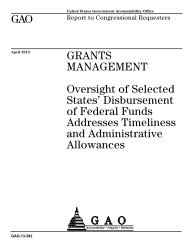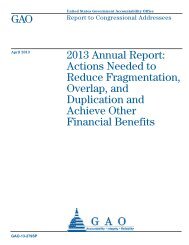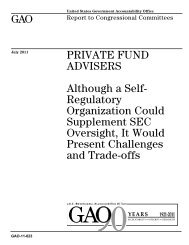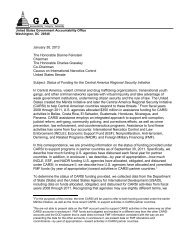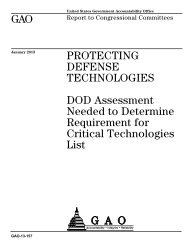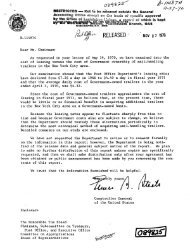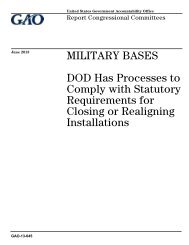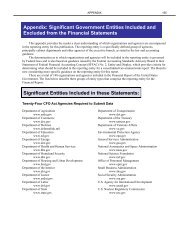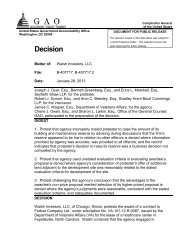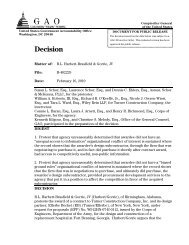View Report (PDF, 34 pages) - US Government Accountability Office
View Report (PDF, 34 pages) - US Government Accountability Office
View Report (PDF, 34 pages) - US Government Accountability Office
You also want an ePaper? Increase the reach of your titles
YUMPU automatically turns print PDFs into web optimized ePapers that Google loves.
--<br />
/’
GAO<br />
Results in Brief<br />
United States<br />
General Accounting <strong>Office</strong><br />
Washington, D.C. 20548<br />
National Security and<br />
International AfTairs Division<br />
B-260371<br />
March 17,1995<br />
The Honorable William J. Perry<br />
The Secretary of Defense<br />
Dear Mr. Secretary:<br />
The Congress, the executive branch’s National Performance Review, and<br />
the Department of Defense (DOD) have emphasized the need for reforming<br />
the federal government’s acquisition processes. The federal acquisition<br />
system has been described as complex, unwieldy, and in need of<br />
comprehensive reform. One key aspect of the current reforms is to use<br />
commercial procurement practices to buy commercial products.<br />
Army officials have cited the acquisition of the Army’s New Training<br />
Helicopter (NTH) as an early example of success in streamlining its<br />
acquisition process to buy a commercial item. In this report, as a “case<br />
study,” we (1) compare this Army acquisition with acquisitions by two of<br />
the largest private sector purchasers of similar helicopters to determine<br />
key differences between these buys and the reasons for such differences,<br />
(2) identify successes the fb-my achieved in streamlining the NTH<br />
acquisition, and (3) discuss potential improvements that could be achieved<br />
from acquisition reform efforts. Our comparison is not intended to suggest<br />
that the identified private sector processes would be appropriate for a<br />
government procurement. However, as the government moves to greater<br />
use of commercial practices to procure commercial items, a comparative<br />
analysis can be a helpful tool in gauging status and progress.<br />
The Army’s acquisition of the NTH was vastly different than private sector<br />
companies’ acquisition of similar helicopters. Specifically, the Army’s<br />
acquisition took longer, involved more people, and generated significantly<br />
more paperwork.<br />
Key reasons for these differences were that the Army’s procurement<br />
included<br />
l the need to comply with a myriad of laws and regulations;<br />
l more extensive and less flexible system requirements; and<br />
l numerous documentation requirements for the proposal and award<br />
process, including contingencies such as bid protests.<br />
Page 1 GAOINSIAD-95-54 Acquisition Reform
Background<br />
B-260371<br />
Nevertheless, in procuring the NTH, the Army streamlined its acquisition<br />
process somewhat and used more commercial-type practices. For<br />
example, it adapted a commercial helicopter for the NTH rather than<br />
pursuing a lengthy development program, deleted a number of data<br />
requests and contract clauses from the request for proposals (RFP), and<br />
used commercial standards in lieu of military specifications and standards.<br />
In addition, the Army requested fewer program evaluations and other<br />
documents than are normally required in the acquisition process-these<br />
include functional areas such as testing, safety, and logistics.<br />
We believe the Army could have made further improvements through<br />
quicker approval of deviations and waivers and additional reductions in<br />
contractors’ paperwork requirements. However, to significantly reduce the<br />
differences between the Army’s and commercial sector’s acquisitions,<br />
further reforms, such as those proposed by the Secretary of Defense and<br />
called for in the recently enacted Federal Acquisition Streamlining Act of<br />
1994, need to be implemented. For example, the act should significantly<br />
expand and simplify the procurement of commercial items because it<br />
stipulates a preference for such items and eliminates the applicability of<br />
certain laws and cIauses previously required. We believe, therefore, that<br />
the Army’s NTN acquisition could be used as a baseline against which<br />
further improvements that might result from acquisition reform initiatives<br />
could be measured. However, for combat or other missions that can only<br />
be satisfied by unique development efforts, the NTH would likely not<br />
provide an appropriate baseline.<br />
The DOD acquisition system has been described as a complex web of laws,<br />
regulations, and policies adopted to, among other things, ensure<br />
standardized treatment of contractors; prevent fraud, waste, and abuse;<br />
and further socioeconomic objectives. This complex situation has been<br />
cited by DOD officials as adding to (1) the time to procure commercial<br />
items from the private sector and (2) the costs of such items in terms of<br />
administrative burdens placed upon both DOD and its suppliers. Several<br />
efforts are underway to change the way DOD buys commercial items. One<br />
approach is to streamline or eliminate as many government-unique<br />
requirements in the procurement of commercial items as possible. This is<br />
what the Army stated was done in the procurement of its NTH.<br />
Although the NTH acquisition began several years before the current reform<br />
efforts, the Army’s objective was to streamline the cost of entry-level<br />
Page 2 GAO/NSIAD-95-54 Acquisition Reform
Figure 1: The Army’s New Training<br />
Helicopter<br />
B-260371<br />
rotary wing training by using a “not-business-as-usual” approach to the<br />
acquisition process. To reduce the cost of this training without degradmg<br />
its effectiveness, the Army sought to replace the UH-1 Huey with a<br />
commercial helicopter that had lower operating costs. The Huey, although<br />
more effective than the system it replaced, was also more expensive to<br />
operate and maintain. A 1989 study estimated that expenses could be<br />
reduced by about $40 million a year by using a new training helicopter<br />
rather than the Huey. Thus, the Army incurred extra cost every year until<br />
the NTEI replaced the Huey.<br />
The Army awarded a contract in March 1993 to Bell Helicopter, Textron<br />
Incorporated, for delivery of 157 NTHS and 12 cockpit trainers with<br />
deliveries beginning in October 1993. The contract price was about<br />
$85 million. The Army began training with the aircraft-a commercial<br />
nondevetopmental item’ that was certified by the Federal Aviation<br />
Administration (&%)-in April 1994. The NTH, as shown in figure 1, is now<br />
being used for all phases of the Army’s entry level rotary wing training.<br />
‘DOD regulations define a nondevelopmental item to include, among other things, commercial items<br />
and commercial items modified for military use. In 1994, the Federal Acquisition Streamlining Act<br />
defined commercial items to include items available to and used by the general public that incorporate<br />
minor modifications to meet federal requirements.<br />
Page 3 GAOINSIAD-95-54 Acquisition Reform
Army’s NTH Buy<br />
Differs From Private<br />
Sector Helicopter<br />
Buys<br />
B-260371<br />
Our comparison of the Army’s NTH and the private sector purchasers’<br />
processes is limited in a number of respects. For example, the Army NTH<br />
buy consisted of 157 helicopters while the private purchasers stated that,<br />
for them, a large buy would be about 10 aircraft. However, since DOD is<br />
moving toward adapting the processes of world class customers in buying<br />
commercial products and the Army has identified the NTH as a successful<br />
commercial procurement, we believe these commercial purchasers’<br />
processes can serve as an indicator of progress in moving away from<br />
government-unique terms, conditions, and practices. Appendix I details<br />
the acquisition process for both the Army NTH buy and the private sector<br />
purchasers included in our work.<br />
Differences we noted in the Army’s NTH buy and acquisitions by the private<br />
sector purchasers we spoke with appear quite significant. One main<br />
difference is that the Army’s NTH acquisition took more time. From the<br />
time the need was identified in 1986 to initial aircraft delivery in 1993 was<br />
7 years. Of this time, it took about 23 months from the time Congress<br />
approved funding for the purchase in November 1991 to initial delivery in<br />
October 1993. In comparison, the major private sector purchasers of<br />
helicopters we spoke with stated that their acquisitions of similar<br />
helicopters normally take about 3 months from the time a customer<br />
identifies its need until aircraft delivery. This time frame, according to<br />
these purchasers, does not normally include the time it takes the<br />
customers to develop their requirements and obtain funding for the<br />
aircraft. Whether the 23-month period or some other period is most<br />
appropriate as a comparison with the time required for private sector buys<br />
is debatable; however, DOD and service officials acknowledge that the time<br />
to acquire their aircraft was a considerably longer period than that<br />
required for private sector acquisitions.<br />
Additionally, the Army involved several hundred government personnel in<br />
the acquisition process while the private sector purchasers involved just<br />
five to seven people. However, the government personnel’s involvement<br />
with the acquisition varied significantly from full-time participation to<br />
attending a few meetings. According to Army representatives, a core group<br />
of about 50 people was significantly involved in the program management<br />
and the evaluation and selection of the NTH contractor.<br />
We also noted that during the Army’s NlX acquisition process, contractors<br />
and government officials were required to provide large quantities of data.<br />
For example, the contractors were required to respond to the RFT with<br />
Page 4 GAO/NSIAD-95-54 Acquisition Reform
B-260371<br />
seven separately bound volumes, which included an overall executive<br />
summary for their proposal in one volume, their technical proposal<br />
approach in another, and their cost proposal in another. Furthermore,<br />
numerous copies of each volume were required-specifically, 50 copies of<br />
the executive summary and from 10 to 20 copies of each of the remaining<br />
6 volumes were required. One contractor’s representative stated that its<br />
proposal contained 62 <strong>pages</strong> of life-cycle cost data, including such<br />
information as the parts requirements per month, compared to 1 to 2 <strong>pages</strong><br />
of cost data normally required in a commercial contract. A representative<br />
for another contractor that responded to the RFP stated that a truck was<br />
rented to deliver the proposal because the Army required so many copies.<br />
The private sector purchasers we talked with did not require this type or<br />
quantity of data. We were told that they only asked for a few <strong>pages</strong> of data<br />
Army officials also noted that they were required to submit a number of<br />
program documents, some of which they believed added no value because<br />
a commercial aircraft was being bought. These included a Test and<br />
Evaluation Master Plan and a Safety and Health Data Sheet. Similar<br />
documentation was not required in private sector purchases of<br />
helicopters,<br />
Reasons for Differences Several reasons account for the key differences between Army and private<br />
sector procurement. These include the Army’s (1) compliance with<br />
numerous Iaws and regulations, (2) more extensive and less flexible<br />
system requirements, and (3) need for documentation throughout the<br />
proposal and award process. We were told these were not major factors in<br />
private sector procurements.<br />
Laws and Regulations <strong>Government</strong> procurements are subject to various statutory and regulatory<br />
provisions that place requirements on government personnel and can<br />
require contractors to revise or modify their commercial practices. Such<br />
statutory provisions include (1) competition requirements that were<br />
enacted to obtain low prices, avoid favoritism, and ensure offerers a fair<br />
chance when competing for government contracts; (2) socio-economic<br />
requirements to promote desirable social objectives; and (3) audit<br />
requirements developed to ensure the government obtains what it pays<br />
for. Audit requirements include the Truth in Negotiation Act’s (TINA)<br />
requirement for contractors to submit cost or pricing data Regulatory<br />
guidance includes the Federal Acquisition Regulation (FAR) and DOD’S<br />
acquisition and budget guidances-DOD Directive 5000. l-Defense<br />
Page 5 GAO/?WXAI-95-54 Acquisition Reform
B-260371<br />
Acquisition, and Directive 7’045.1~The Planning, Programming, and<br />
Budgeting System.<br />
<strong>Government</strong> and contractor officials have often identified such<br />
government-unique requirements as impediments to commercial buys. In<br />
fact, one contractor noted that the possibility that the IQH procurement<br />
could have involved TINA requirements almost resulted in his company not<br />
submitting a proposai. Although the planned competitive procurement was<br />
not subject to TINA requirements, the contractor was concerned that<br />
changes in the procurement process or modifications to the NTH contract<br />
after award could in some way involve certified cost or pricing data. In<br />
fact, an August 1992 draft RFP stated that although the contractor may not<br />
be required to submit a signed certificate, “the contracting officer,<br />
however, reserves the right to require the certification if it is determined,<br />
prior to award, that adequate competition does not exist or if the<br />
possibility of overpricing exists.” This could have opened the concerned<br />
company’s books as well as its subcontractors’ books to government<br />
inspections. An Army contracting representative commented that it does<br />
not make sense for the government, when seeking the benefits of buying<br />
commercial products, to place such requirements on contractors whose<br />
products have already been produced for the commercial market.<br />
Concerning regulatory provisions, Directive 5000.1, for example, defines a<br />
disciplined approach to the integration of DOD'S requirements, acquisition,<br />
and budgeting processes. Generally, a DOD acquisition program is<br />
(1) initiated in response to a validated military need that becomes an<br />
approved requirement, (2) prioritized and must compete for funds in the<br />
DOD Planning, Programming, and Budgeting System, and (3) further<br />
prioritied and must vie for funds during the congressional authorization<br />
and appropriation process.<br />
This process of prioritizing and competing for funds frequently results in<br />
changes and causes funding uncertainties. In the case of the NTH, funding<br />
uncertainties related to the budget and appropriation process and the<br />
subsequent change in its acquisition strategy significantly increased<br />
procurement time. Specifically, when the need for a new training<br />
helicopter was recognized in 1986, the Army gave other systems a higher<br />
priority for scarce procurement funds than the new trainer. As a result, the<br />
Army decided to use operations and maintenance funds to lease the<br />
aircraft and in 1990 received congressional approval to do so. Congress<br />
subsequently decided it was more beneficial to buy the aircraft and in<br />
November 1991, provided $23.5 million for the NTH initial procurement.<br />
Page6 GAOINSIAD-95-54 Acquisition Reform
More Extensive and Less<br />
Flexible Requirements<br />
Documentation Related to<br />
Proposal and Award Process<br />
B-260371<br />
The commercial purchasers that we spoke with acknowledged that they<br />
were not subject to such legislative and regulatory constraints.<br />
DOD'S traditional acquisition process is requirements driven; it begins with<br />
an extensive identification of operational and performance requirements<br />
derived from a variety of sources including the intended users Cpilots,<br />
maintenance personnel, and trainers). The initial requirements list is<br />
subjected to scrutiny and compared to, but not limited by, what is<br />
available in the commercial market. For the NTH, the Army specified<br />
83 of its requirements as critical, but several of these, such as a third seat,<br />
crash-worthy fuel cells, and crash-worthy seats, were not available on any<br />
potential competitor’s aircraft. Army representatives said they specified 83<br />
critical requirements because FAA certification assured only basic<br />
requirements and in an area such as aircraft instrumentation NTH students<br />
must have a working knowledge of many more instruments than an FAA<br />
certification required. They also stated that they had to be specific in their<br />
requirements to avoid ambiguity.<br />
In contrast, the two private sector purchasers said they were limited to<br />
commercially available capability and would normally define only a few<br />
requirements as critical. These representatives said that private sector<br />
buyers define their requirements but may choose an item that provides<br />
less. They further stated that, in contrast, the government requires its<br />
contractors to meet stated requirements in an RFP or run the risk of being<br />
found unacceptable. In some instances, they stated that the government<br />
also required competing contractors to identify items capable of exceeding<br />
government-defined requirements. For example, the RF-P for the NTH states<br />
that failure to achieve any critical requirements will result in contractors<br />
being eliminated and also asked contractors to highlight any requirements<br />
that have been exceeded and may result in training and safety benefits or<br />
cost savings. An Army official said that such information was needed in<br />
the NTH “best value” determination to properly assess and value those<br />
items that exceeded the stated minimum requirements.<br />
The government’s proposal and award process has been characterized as a<br />
lengthy series of paperwork hurdles for both the contractor in trying to be<br />
responsive to RFPS and for the government to be prepared for<br />
contingencies such as bid protests. This process can substantially lengthen<br />
the procurement process. AIso if the process is not carried out properly, a<br />
bid protest can ultimately negate the contract award.<br />
Page7 GAO/NSLAD-95-54 Acquisition Reform
Army Streamlined<br />
Acquisition, but<br />
Additional<br />
Improvements Were<br />
Possible<br />
B-260371<br />
The Army was required to (1) provide a 15-day notice to companies before<br />
releasing ms and (2) allow 30 days for such companies to respond.<br />
Additionally, contractors who responded to this RF?, as discussed<br />
previously, had to provide numerous copies of separate volumes of<br />
information. Army officials that were involved with the NTH buy stated that<br />
much of the documentation was required so the government could<br />
evaluate the contractors claims about their helicopter’s performance. FOF<br />
example, contractor claims about life-cycle costs and performance<br />
characteristics had to be substantiated by various individuals within the<br />
acquisition process, and as a result, numerous copies were required.<br />
Again, the private purchasers noted that they did not make such data<br />
requests. We were told that they only ask for a few <strong>pages</strong> of data<br />
Regarding bid protests, FAR Subpart 33-l provides procedures to follow<br />
should contract awards be protested to the agency, the General Services<br />
Board of Contract Appeals (for automated data processing acquisitions),<br />
or our office. Private sector purchasers, however, do not normally<br />
encounter such protests. Army representatives told us that much of the<br />
documentation they requested in the RFP and prepared on their own was<br />
done in case of a bid protest. They stated that since the Nm buy was a<br />
streamlined procurement process, they wanted to ensure that a clear audit<br />
trail documented the actions taken and the reasons why.<br />
A small team was informally formed to participate in meetings with the<br />
offerers and to assist in the review and revision of contract documentation<br />
so that these would be written in a clear, concise, and unambiguous<br />
manner. An Army representative told us that when one of the four<br />
competitors did protest the NTH award to our office,’ the documentation<br />
that had been gathered was essential in showing what happened during<br />
the NTH competition and was instrumental in defending the Army NTH<br />
procurement actions and resolving the protest in favor of the Army.<br />
Much of the Army’s streamlining can be attributed to the fact that it opted<br />
for a commercial helicopter instead of pursuing a development program. A<br />
development program would have added substantial time and cost to the<br />
acquisition. In addition, by selecting a commercial aircraft, the Army was<br />
able to test each offerer’s aircraft using the Army’s operating procedures,<br />
methods, and personnel, Ail of this was done at the manufacturer’s<br />
expense and allowed the Army to avoid an expensive testing program.<br />
Further successes identified by Army officials include: (1) reducing some<br />
‘Enstrom Helicopter Corp., 3253014, Aug. 13, 1993,932 CPD 189.<br />
Page 8 GAO/NSIAD-95-54 Acquisition Reform
Army Test Program<br />
Avoided, but<br />
Manufacturers Incurred<br />
Significant Costs<br />
System Requirements<br />
Reduced, but Further<br />
Improvements May Have<br />
Been Possible<br />
EL-260371<br />
system requirements to make it easier for some contractors to compete;<br />
(2) deleting some unnecessary data requests, contract clauses, and<br />
specifications from the NTH RFP; and (3) preparing fewer program<br />
evzduations and related documents. Although progress was made in these<br />
areas, further improvements were possible.<br />
Army officials noted that, in pursuing an F&&certified aircraft, they saved<br />
money and reaped many benefits by performing a Training Effectiveness<br />
User Evaluation (TEUE) on the manufacturer’s aircraft instead of<br />
conducting an expensive test program. The TEUE, according to these<br />
officials, provided a means for the Army to test the NTH and see if it would<br />
do the intended mission using the actual operating procedures, methods,<br />
and personnel+ This test was accomplished at the manufacturer’s expense<br />
and the aircraft remained the manufacturer’s responsibility. While this test<br />
may have been a significant cost benefit for the Army, some<br />
representatives of the manufacturers told us that the TEUE was expensive<br />
for them. One such official told us that, because of the costs relative to the<br />
TEUE, his company would not participate in an effort like this again.<br />
Army officials stated that the procurement package used in the NTH buy<br />
incorporated flexibility regarding what was an acceptable requirement<br />
and, as a result, some system requirements were reduced. Specifically,<br />
they stated that dassifying their requirements as critical and noncritical<br />
allowed the acceptance of less than specified needs for noncritical<br />
requirements. Based on its analysis of comments received from<br />
competitors, the Army reduced several requirements, including<br />
l airspeed from 100 to 90 knots,<br />
l a hover altitude from 4,000 feet density to 2,300 feet density,<br />
. fuel capacity from 3-l/2 hours to 2-112 hours, and<br />
l air-frame crash-worthy limits from 26-feet-per-second to a limit open to<br />
discussion based on contractor data.<br />
An Army representative said that the reductions in these requirements<br />
made it easier for contractors to compete. In fact, one contractor avoided<br />
elimination from competition when the airspeed requirement was lowered<br />
from 100 to 90 knots.<br />
Although some requirements were reduced, contractors who responded to<br />
the NTH sohcitation noted that further Army concessions would have made<br />
Page 9 GAOINSIAD-95-54 Acquisition Reform
Contractor Workload<br />
Reduced, but More Is<br />
Needed<br />
B-260371<br />
it less burdensome in terms of people needed and paperwork required for<br />
them to develop special Army-unique items. While requirements were<br />
separated into critical and noncritical, contractors were still required to<br />
respond to each. Furthermore, as previously noted, 83 requirements were<br />
classified as critical. One requirement that contractors believed could have<br />
been reduced was the ‘three seat” cockpit configuration whereby, in<br />
addition to the instructor and student pilot, a second student in the aircraft<br />
must have an unobstructed view of the instruments. Contractors stated<br />
that this was the most difficult and costly requirement for them to meet.<br />
Army representatives, however, stated that the cockpit configuration was<br />
a critical requirement that was needed to save time and money. They<br />
noted that because a second student was being exposed to and trained in<br />
the cockpit environment and could interact with the instructor and other<br />
student pilot, training time should be reduced.<br />
The Army took several actions to streamline the acquisition of the NTH and<br />
ease requirements on potentid COnlXaCtOrS. The RF-P, for example, was<br />
shortened from an initial draft of 330 <strong>pages</strong> to a final version of about<br />
100 <strong>pages</strong>. Army representatives said they eliminated unnecessary data<br />
requirements, contract clauses, and references to miLitary specifications.<br />
For instance, an Army representative stated that 21 of 27 proposed data<br />
items cited in the original RFT were unneeded and were subsequently<br />
removed. The data demand for engineering change proposals, for example,<br />
was removed from the RFP because the contractor rather than the Army<br />
had configuration management responsibility. This data demand would<br />
have required (1) the contractor to prepare engineering change proposal<br />
documents, (2) Army engineers to evaluate and approve them, and (3) the<br />
contractor to wait until funding was made available before proceeding<br />
with the engineering changes. Further, the contractor would have had to<br />
submit 28 copies of each change proposal for the Army to evaluate and<br />
process.<br />
The Army also eliminated about 98 contract clauses that were identified by<br />
either the Army or contractors as being unneeded. As a result, the final RFP<br />
referred to only 64 separate contract clauses, which are listed in<br />
appendix II, and included the fuU text of 8 other clauses.<br />
Additionally, in purchasing an FM-certified aircraft, the Army relieved<br />
contractors of the cost of complying with extensive military specifications<br />
and standards. Furthermore, other specifications and standards were<br />
eliminated during the RFP review process. For example, the Army<br />
Page 10 GAO,%SIAD-95-54 Acquisition Reform
Fewer Assessments and<br />
Program Evaluations, but<br />
Waivers and Deviations<br />
Took Too Long<br />
B-260371<br />
eliminated Military Specification MILQ-9858A, “Quality F’rogram<br />
Requirements,” from the final RFT since quality control processes, although<br />
less onerous, were already imposed under the FAA certification. DOD and<br />
contractor officials have often said that MTLQ-9858A causes extensive<br />
government oversight and additional contractor cost in assuring<br />
compliance with various provisions for quality control such as maintaining<br />
detailed records of tests and inspections taken in response to test<br />
deviations, scrapped materid, and process trends. Army officials told us<br />
that this specification was not required for commercial aircraft but could<br />
have been imposed in the NTH contract. Accordingly, compliance with this<br />
specification could have added a substantial burden, especially on<br />
contractors who did not do business with the government and did not<br />
already have a system that met this requirement.<br />
Despite the above reductions, the government still required a multitude of<br />
data from offerers. This included the volumes of data in response to the<br />
RFT and various details not typically provided to commercial customers<br />
such as technical manuals and data about technical support. According to<br />
the contractors, these requirements create a significant paperwork burden<br />
because they must prepare and submit the documents to be considered for<br />
contract award. A number of them stated that they spent millions of<br />
dollars in preparing proposals and competing for the NTH contract. In<br />
commenting on these data requirements, Army officials said that such data<br />
could be justified by the significant differences between the nature of<br />
Army operations and the private sector and by differences in the number<br />
of aircraft bought.<br />
In addition to easing the paperwork burden on contractors, the Army was<br />
able to streamline the acquisition process by waiving some reports, plans<br />
and evaluation requirements. Some Army NTH representatives said the<br />
waived documents were non-value-added because the NTH was an<br />
FAA-certified aircraft with no combat mission. Waived reports include the<br />
operational test and evaluation report that would have required time,<br />
manpower, and other Army assets to prepare. For example, resources<br />
would have been required to perform the test, which would have involved<br />
participants from several Army testing and evaluation agencies as well as<br />
Army pilots. The use of these resources could translate into substantial<br />
costs to the Army. Other documents that Army representatives said they<br />
waived because they were unneeded include:<br />
Page II GAON?dAD-95-54 Acquisition Reform
B-260371<br />
l System Threat Assessment <strong>Report</strong>, which documents the Army’s threat<br />
assessment against a specific system. This assessment was waived<br />
because the NTH is a training helicopter that has no combat mission.<br />
9 Live Fire Test and Evaluation <strong>Report</strong>, which is provided to Congress to<br />
report results of realistic survivability or lethality testing. This report was<br />
waived because the NTH is solely a training device with no combat mission.<br />
l Development Test and Evaluation <strong>Report</strong>, which provides the results of<br />
developmental test and evaluation of a system. This evaluation was waived<br />
because the NTH is a nondevelopmental item and an FM-cetied aircraft.<br />
The A-my experienced delays in obtaining some deviations and waivers<br />
because of legal concerns and pressure from officials in functional areas<br />
within the acquisition process. For example, the Army requested a<br />
deviation from the legal prohibition against allowing contract financing on<br />
commercial products3 It took several months to obtain and did not arrive<br />
soon enough for the Army to avoid developing three different options to<br />
include in the RFP because of the uncertainty about whether the deviation<br />
would be granted before the RFP due date.<br />
One of the NTH competing contractors told us this was an example of the<br />
government being out of “sync” with commercial procurement practices<br />
by allowing fewer financing options than are normally availabIe in the<br />
private sector. An Army representative said failure to provide government<br />
financing on commercial procurement such as the NTH could impede firms,<br />
especially smaller firms, from bidding on government contracts for<br />
commercial products. The impediment would result because firms would<br />
have to invest their own funds or borrow large sums to finance production<br />
if government financing is not available.<br />
Army officials also identified some program documents as adding little or<br />
no value to the urn buy. In these instances, NTH program office<br />
representatives explained that sometimes it was simpler to prepare the<br />
requested documents than to obtain waivers because some functional<br />
proponents had higher level support than the program manager. For<br />
example, an NTH Program <strong>Office</strong> representative said the office yielded to<br />
pressure from the testing community by preparing a Test and Evaluation<br />
Master Plan, which when approved said little more than development and<br />
operational testing were not necessary because the Nm is a commercial<br />
helicopter. The Army hired a contractor to prepare this 64-page plan,<br />
which was completed in about a year and cost about $70,000.<br />
“The Federal Acquisition Streamlining Act, enacted in October 1994, eliminates this prohibition and<br />
authorizes government financing under such terms and conditions as are appropriate or customary in<br />
the commercial marketplace for commercial items. This includes advance payments up to 15 percent.<br />
Page 12 GAOINSIAD-95-54 Acquisition Reform
Acquisition Reform<br />
May Offer Additional<br />
Opportunities<br />
DOD’s Blueprint for a<br />
Commercial Purchasing<br />
Environment and Recent<br />
Legislative Reforms<br />
B-260371<br />
In addition to the Test and Evaluation Master Plan, other examples of<br />
program documents that added little or no value, according to Army<br />
officials, included:<br />
. Human Factors Engineering <strong>Report</strong>, which identified concerns such as the<br />
minimization of crew workload for the NTH. While the program manager<br />
was able to eliminate certain sections of the report, he was unable to<br />
waive the entire document.<br />
. System MANPRINT Management Plan, which provided optimum man and<br />
machine interface for the already designed nondevelopmental item.<br />
l Computer Resources Life Cycle Management Plan, which was a 22-page<br />
plan that stated that since the NTH is a commercial, nondevelopmental<br />
item, no unique software for operation or support was required.<br />
l Safety and Health Data Sheet, which provided information about safety;<br />
radioactive materials; explosives and hazardous materials; munitions; and<br />
health hazards, such as acoustical energy, biological and chemical<br />
substances, oxygen deficiency, and radiation energy. Although the NTH<br />
solicitation specifically required an FAA-certified aircraft, the safety<br />
functional proponents ultimately required the Army to prepare the data<br />
sheet. Army proponents of the Safety and Health Data Sheet insisted that<br />
noise test data be gathered for the NTH. The Program <strong>Office</strong>, the FAA, and<br />
the contractor believed that such data was unnecessary because this was<br />
an FAA-certified aircraft and over 4,000 BeIl Jet Rangers were flying.<br />
To significantly reduce differences between the Army’s and commercial<br />
sector’s acquisition processes, further reforms-such as those set forth by<br />
the Secretary of Defense and Congress-would be required. Specifically,<br />
many of the laws, regulations, and other reasons for the extended NTH<br />
acquisition process, the numerous participants, and extensive paperwork<br />
requirements could be reduced when various DOD initiatives and the<br />
recently signed Federal Acquisition Streamlining Act of 1994 are<br />
successfully implemented.<br />
In February 1994, the Secretary of Defense told Members of Congress that<br />
it was imperative that the United States be able to rapidly obtain<br />
commercial and other state-of-the-art products and technology to meet<br />
post-Cold War security challenges. He noted, however, that the DOD<br />
acquisition process-which is subject to considerable “stove-piping” of<br />
functions and massive coordination requirements, in addition to extensive<br />
laws, regulations, and oversight requirements-basically impeded DOD'S<br />
Page 13 GAO/NSW-95-54 Acquisition Reform
B-260371<br />
access to such commercial items. As an example, he stated that, under the<br />
current process, DOD was often unable to buy commercial products, even<br />
when they were cheaper. He tien presented his vision to transform DOD'S<br />
acquisition process into a commercial purchasing environment. This vision<br />
statement was based on recommendations in the executive branch’s<br />
National Performance Review and the Section 800 Panel report4<br />
Among other things, the Secretary asserted that acquisition laws and<br />
regulations must separately define and state a clear preference for<br />
commercial items over other nondevelopmental items, and specially<br />
designed items. To accomplish this, he contended that commercial<br />
acquisitions should be exempt from government-unique laws, regulations,<br />
procedures, processes, or practices. He noted that acquisition policies and<br />
processes must be structured so that the fewest number of people are<br />
involved in a given process and the time required to acquire products and<br />
services is substantially reduced.<br />
He further stated that there should be (1) a mandatory exemption from<br />
TINA requirements to submit cost or pricing data for most commercial item<br />
acquisitions and (2) approval of and authorization of waivers for the DOD<br />
pilot programs. The Section 800 Panel report noted that TINA requirements<br />
created a barrier for the use of commercial and modified commercial<br />
products by DOD. The Panel, in recognition of TINA’S adverse impact,<br />
drafted an alternative pricing provision. The Secretary requested the TINA<br />
exemption as a major step to creating a commercial purchasing<br />
environment. Regarding the pilot programs, he noted that, since some time<br />
will be needed to revise regulations and train personnel in the new<br />
purchasing environment, approval of DOD's pilot programs would “jump<br />
start” acquisition reform by allowing the immediate purchase of<br />
commercial and commercial-like items using commercial practices.<br />
In October 1994, Congress passed the Federal Acquisition Streamlining<br />
Act, which incorporated many of the Secretary’s proposals. Through this<br />
act, Congress, among other things, sought to encourage the purchase of<br />
commercial items in the government and reduce impediments to these<br />
purchases. One provision required the FAR to include a list of statutes that<br />
are inapplicable to contracts and subcontracts for acquiring commercial<br />
items. Several such statutes were identified in the act and included the<br />
ones related to<br />
4Thii is DOD’s Acquisition Law Advisory Panel’s report entitled Streamlining Defense Acquisition<br />
e, which was convened under Section 800 of the National Defense Authorization Act of 1991.<br />
Page 14 GAOLNSIAD-95-54 Acquisition Reform
B-260371<br />
l contingent fee cetications,<br />
9 Anti-Kickback Act procedural requirements,<br />
l Drug-Free Workplace Act requirements,<br />
. subcontractor direct sales limitations to the United States,<br />
. suspended or debarred subcontractors identification requirements,<br />
l procurement integrity certifications, and<br />
l Clean Air Act certifications+<br />
Such government-unique requirements were found to be inconsistent with<br />
normal commercial practice and a driver of increased administrative<br />
expenses and paperwork for commercial companies awarded government<br />
contracts for commercial items. ALl of the above requirements were<br />
included in the NTH solicitation. At the time of our review, DOD officials<br />
informed us that, as part of the regulatory implementation of the Federal<br />
Acquisition Streamlining Act of 1994, they have ongoing efforts to develop<br />
the lists of inapplicable statutes for commercial procurements.<br />
Additionally, the act includes, among other things, provisions that:<br />
l Establish a clear preference for the use of commercial items over other<br />
nondevelopmental items and unique government-designed items (as set<br />
forth in the Secretary’s vision).<br />
l Require preliminary market research before developing new specifications<br />
and before soliciting any bids or proposals in excess of $100,000. This was<br />
done to determine whether agency needs could be met by available<br />
commercial items and is a process quite similar to the way the private<br />
companies we spoke with make purchases-that is, identifying what is in<br />
the market and making tradeoffs instead of using the more independent<br />
requirement development process that existed for the NTH buy.<br />
As previously noted, the act also authorizes commercial item payments<br />
using commercial terms and conditions when in the best interest of the<br />
United States. Under this arrangement, financing payments could be used<br />
unless the agency head determines that such payment is inconsistent with<br />
terms and conditions in the commercial marketplace or not in the<br />
government’s interest. As discussed, such a change could have been<br />
beneficial in the NTH procurement and would have precluded the time lag<br />
and other problems associated with the NTH F’rogram <strong>Office</strong>’s attempt to<br />
waive the prohibition on contract financing for commercial items.<br />
Additionally, the act includes certain provisions that are designed to<br />
improve the purchasing environment for commercial items. These include<br />
Page 15 GAOINSIAD-95-54 Acquisition Reform
B-260371<br />
the (1) authorization of DOD pilot programs to test innovative procurement<br />
procedures and (2) exemptions to TINA requirements for the submission of<br />
cost or pricing data Regarding the DOD pilot programs, Congress approved<br />
special statutory authority for five of the seven acquisition programs<br />
originally nominated by DOD, To date, DOD has granted the participating<br />
programs waivers from regulations not required by statute, and worked<br />
with the programs to develop measurement processes to determine the<br />
success of the acquisition approaches made possible by waivers.<br />
Regarding TINA requirements on commercial items that are not acquired<br />
competitively, the act requires the contracting officer to seek information<br />
on prices at which the same or similar items have been sold in the<br />
commercial market. If the information is adequate to evaluate price<br />
reasonableness, the contracting officer must exempt the procurement<br />
from cost and pricing data requirements.<br />
These and other changes appear to be a big step toward reducing the “red<br />
tape” and administrative burdens associated with the government’s<br />
acquisition of commercial items. It should be noted, however, that no one<br />
has data on how much such reforms will reduce the cost, time, number of<br />
participants, or paperwork required in DOD'S acquisition of commercial<br />
items. DOD officials, however, have stated that they currently have ongoing<br />
efforts to quantify and collect such data. This type of information is key in<br />
determining whether adapting commercial practices to procure<br />
commercial items wilI provide significant benefits to DOD. We, therefore,<br />
believe that the Army’s NTH streamlining effort could be used as a baseline<br />
against which further improvements that might result from acquisition<br />
reforms could be measured. However, some combat or other missions are<br />
only satisfied by unique development efforts (such as the B-Z and F-22). In<br />
such cases, the NTH would likely not provide an appropriate baseline.<br />
Agency Comments In commenting on a draft of this report, DOD stated that it concurred with<br />
the report. DOD also agreed that the Federal Acquisition Streamlining Act<br />
offers even more opportunity for the use of commercial practices and for<br />
improved government procurement of commercial type items. DOD'S<br />
comments are reprinted in their entirety in appendix III.<br />
Scope and<br />
Methodology<br />
We reviewed the Army’s NTH acquisition and related documentation<br />
including, but not limited to, various draft and the final RFP, and an Army<br />
after action report entitled “New Training Helicopter Acquisition Process.”<br />
We compared this NTH acquisition to acquisitions of similar commercial<br />
Page 16 GAO/XXAJI-95-54 Acquisition Reform
B-260371<br />
helicopters made by private firms. To accomplish our objectives, we<br />
gathered and analyzed applicable data regarding each of the above and<br />
interviewed a number of officials within the Army, DOD, and the private<br />
sector. These included individuals from: the U.S. Army NTH Product <strong>Office</strong><br />
at the Army Aviation and Troop Command in St. Louis, Missouri; the<br />
Army’s Aviation Training Brigade located at Fort Rucker, Alabama; Bell<br />
Helicopter, Textron Incorporated, located in Fort Worth, Texas; the<br />
Defense Plant Representative’s <strong>Office</strong> located at Bell Helicopter; American<br />
Eurocopter Corporation located in Grand Prairie, Texas; Premier<br />
Helicopter Company located in Grand Prairie, Texas; Enstrom Helicopter<br />
Corporation located in Menominee, Michigan; Grumman Aerospace and<br />
Electronics Corporation located at Bethpage, New York; and Petroleum<br />
Helicopter, Incorporated, and Keystone Helicopter Corporation-two<br />
major private sector helicopter purchasers-located in Lafayette,<br />
Louisiana, and Westchester, Pennsylvania, respectively.<br />
In addition, we reviewed (1) the Secretary of Defense’s acquisition reform<br />
plan entitled “Acquisition Reform: A Mandate for Change,” which was<br />
presented before the House Committee on Armed Services on February 9,<br />
1994; (2) the Federal Acquisition Streamlining Act of 1994, Public Law<br />
103-355; and (3) various reports and studies relative to commercial<br />
practices and the federal government’s procurement of helicopters, We<br />
conducted our work between February and December 1994 in accordance<br />
with generally accepted government auditing standards.<br />
We are sending copies of this report to interested congressional<br />
committees. We will make copies available to others upon request. Please<br />
contact me on (202) 512-4587 if you have any questions concerning this<br />
report. Major contributors to this report are listed in appendix IV.<br />
Sincerely yours,<br />
David E. Cooper<br />
Director, Acquisition Policy, Technology,<br />
and Competitiveness Issues<br />
Page 17 GAo/NSm-95-54 Acquisition Reform
Contents<br />
Letter<br />
Appendix I<br />
Process for Army<br />
NTH Buy and Process<br />
Used by Some Private<br />
Sector Purchasers of<br />
Similar Helicopters<br />
1<br />
Appendix II<br />
Contract Clauses<br />
Appendix III<br />
Comments From the<br />
Department of<br />
Defense<br />
Appendix IV<br />
Major Contributors to<br />
This <strong>Report</strong><br />
Army’s NTH Acquisition<br />
Private Sector Procurement<br />
Table Table 1.1: Key Events in the NTH Acquisition 20<br />
Figure 1: The Army’s New Training Helicopter<br />
Abbreviations<br />
DOD<br />
FAA<br />
FAR<br />
NITI<br />
TEUE<br />
TINA<br />
RFP<br />
Department of Defense<br />
Federal Aviation Administration<br />
Federal Acquisition Regulation<br />
New Training Helicopter<br />
Training Effectiveness User Evaluation<br />
Truth in Negotiation Act<br />
request for proposals<br />
Page 18 GAO/NSIAJJ-95-54 Acquisition Reform<br />
20<br />
20<br />
24<br />
27<br />
29<br />
30
Page 19<br />
GAO/NSlAD-95-54 Acquisition Reform<br />
1<br />
/<br />
1<br />
5<br />
I
Process for Army NTH Buy and Process<br />
Used by Some Private Sector Purchasers of<br />
Similar Helicopters<br />
Army’s NTH<br />
Acquisition<br />
Table 1 .l : Key Events in the NTH Acquisition<br />
The Army’s NTH acquisition strategy changed over the life of the program.<br />
Initially, the Army proposed a lease it called a “turnkey” or Single<br />
Contractor Aviation Trainer concept where one contractor would provide<br />
aircraft maintenance, support, and conduct the Initial Entry Rotary Wing<br />
flight training using contractor instructor pilots. Concerns about the cost<br />
of the concept and its potential to adversely impact existing training<br />
operations resulted in the Army revising its plan to a lease with an option<br />
to buy. The Army received congressional authorization in November 1990<br />
for a Syear lease of the trainer aircraft. However, Congress repealed this<br />
authorization the following year and directed the Army to present a tiect<br />
buy strategy.<br />
The NTH acquisition extended over about 7 years from the time the need<br />
for the NTH was identified in 1986 to initial aircraft delivery in 1993. For the<br />
first 4 years, most of the effort was devoted to leasing because<br />
procurement funds were not available. Concurrent with finalizing whether<br />
to lease or buy, the Army was involved in developing and approving<br />
detailed operational and performance requirements for the NTH. As<br />
discussed below, this was an iterative process throughout the acquisition<br />
cycle that involved numerous participants such as the users, potential<br />
contractors, and the buying commands.<br />
Table 1.1 provides an overview of key events during the 7-year acquisition<br />
of the NTH. The table is followed by a more detailed discussion of key<br />
events of each acquisition phase.<br />
Year Phase Responsible organization’ Participants and events<br />
1986 R Headquarters Army Vice Chief of Staff directs new training<br />
helicoDter be acauired.<br />
1987 R Aviation Center User representatives meet to discuss requirements<br />
for the NTH.<br />
1988<br />
P Buying command Industry interest in NTH solicited via a Commerce<br />
Business Daily announcement.<br />
P<br />
Contractors<br />
Several contractors respond to the Commerce<br />
Business Daily announcement.<br />
P<br />
R<br />
R p<br />
Aviation Center<br />
Training Device Program Manager<br />
Contractors<br />
Communicates with contractors about NTH.<br />
Tasks contractor to perform an economic analysis<br />
of initial entry rotary wing training.<br />
Meet with congressional representatives about the<br />
NTH txoaram.<br />
N Aviation Center Begins purging prior tratner out of inventory.<br />
(continued)<br />
Page 20 GAOINSIAD-95-54 Acquisition Reform
Appendix I<br />
Process for Army NTH Buy and Process<br />
Used by Some Private Sector Purchasers of<br />
Similar Helicopters<br />
Year Phase Resaonsible organizationa Participants and events<br />
1989 A Headquarters Briefs House and Senate Armed Services<br />
Committees on planned acquisition.<br />
1990<br />
1991<br />
R<br />
R<br />
Aviation Center<br />
Training Device Program Manager<br />
Provides Training and Doctrine Command with<br />
requirement document.<br />
Completes economic analysis of an integrated<br />
system for initial rotary wing iraintnq.<br />
R Training and Doctrine Command<br />
Approves<br />
contractor.<br />
economic analysis performed by<br />
P Aviation Center Issues draft request for proposals.<br />
P Training Device Program Manager Briefs Army Aviation Center on lease concept for<br />
NTH.<br />
R Headquarters Validates economic analysis performed by<br />
contractor.<br />
R<br />
P<br />
P<br />
P<br />
N<br />
N<br />
s, P<br />
S<br />
P<br />
R<br />
Training and Doctrtne Command<br />
Headquarters<br />
Headquarters; Training and Doctrine Command<br />
Program Manager for Training Devices<br />
Headquarters<br />
Congress<br />
Training Device Program Manager<br />
Buying command<br />
Headquarters<br />
Buying command<br />
Contractors<br />
Congress<br />
Headquarters<br />
Program Executive <strong>Office</strong>-Aviation<br />
Headquarters<br />
Contractors<br />
Program Executive <strong>Office</strong>-Aviation<br />
Approves Commercial Training Device<br />
Requirement document.<br />
Reviews draft lease language.<br />
Authorizes acquisition of NTH from a requirements<br />
standpoint.<br />
Performs market survey of commercial users.<br />
Army Acquisition Executive directs the NTH to be<br />
manaaed bv the Armv buvina command.<br />
Authorizes a 5-year lease of the NTH.<br />
Transfers management responsibility to Army<br />
buying command.<br />
Convenes senior level review board and requests<br />
designation of source selection authority.<br />
Army Acquisition Executive appoints source<br />
selection authoritv.<br />
Issues draft request for proposals.<br />
Respond and comment on draft request for<br />
oroposafs.<br />
Repeals lease for the NTH.<br />
Army Acquisition Executive directs the NTH be<br />
managed by Program Executive <strong>Office</strong>-Aviation.<br />
Transfers NTH funding and staffing from Army<br />
buying command to Program Executive<br />
<strong>Office</strong>-Aviation; issues a revised draft request for<br />
proposal to contractors.<br />
Source selection authonty appoints the source<br />
selection advisory council.<br />
Respond and comment on revised draft request for<br />
proposal.<br />
Asks for a revalldation of Commercial Training<br />
Device Requirement document.<br />
(continued)<br />
Page 21 GAO/NSIAD-95-54 Acquisition Reform
Year<br />
1992<br />
1993<br />
Requirements<br />
Determination<br />
Appendix I<br />
Process for Army NTH Buy and Process<br />
Used by Some Private Sector Purchasers of<br />
Similar Helicopters<br />
Phase Responsible organizationa Participants and events<br />
R Training and Doctrine Command Revalidates Commercial Training Device<br />
Requirement document.<br />
S Program Executive <strong>Office</strong>-Aviation First source selection advisory council meeting<br />
held at buying command.<br />
S Test and Experimentation Command Conducts Training Effectiveness User Evaluation<br />
(TEUE) pretest Fort Rucker. at Fort Rucker.<br />
P Aviation Center Hosts presolicitation conference for potential<br />
contractors.<br />
S Program Executive Off ice-Aviation Source selection plan completed.<br />
P Test and Experimentation Command Attends presoticitation conference at Fort Rucker.<br />
S Program Executive <strong>Office</strong>-Aviation Second source selection advisory council meeting.<br />
S Test and Experimentation Command Prepares the TEUE test plan.<br />
P Program Executive <strong>Office</strong>-Aviation Issues final request for proposals and hosts<br />
preproposal conference for contractors.<br />
P Contractors Submit proposals.<br />
S Aviation Center Hosts TEUE.<br />
S Contractors Attend TEUE at Fort Rucker.<br />
-<br />
S Program Executive <strong>Office</strong>-Aviation - Source selection advisory council meetings III<br />
through V.<br />
S Contractors Submit best and final offers.<br />
s Program Executive <strong>Office</strong>-Aviation Holds source selection advisory council meetings<br />
VI and VII.<br />
S Headquarters NTH selection coordinated with actina Army<br />
Acquisition Executive.<br />
C Program Executive Offlce-Aviation Contract awarded March 30.<br />
C Aviation Center Receives first NTH in October.<br />
aOrganlzations referenced are Army except for Congress and contractors,<br />
Legend for phases<br />
R = Requirements determination<br />
P = Proposal soilcitation<br />
S = Source selection<br />
C = Contract award/delivery<br />
N = Not appkabfe<br />
The Army identified a need for a new training helicopter in July 1986 to<br />
replace the aging and difficult to maintain helicopter then used for initial<br />
rotary wing training. The Army’s process for developing operational and<br />
performance requirements began with discussions with various user<br />
Page 22 GAOIMXAD-95-54 Acquisition Reform
Appendix I<br />
Process for Army NTH Buy and Process<br />
Used by Some Private Sector Purchasers of<br />
Similar Helicopters<br />
organizations [such as pilots, maintainers, and trainers). The Army<br />
eventually defined its NTH requirements to include<br />
l a turbine-powered engine,<br />
l three seats,<br />
+ dual controls,<br />
l 90 knot airspeed, and<br />
1 selected crash-worthy features.<br />
In 1989, the Army’s training school approved a statement of operational<br />
and performance requirements that added additional details on various<br />
categories of these requirements such as cockpit environment, navigation<br />
and communication capabilities, maintainability, and reliability. In<br />
February 1990, the operational and performance requirements were<br />
approved and in mid-1990, an Army assembled team visited and surveyed<br />
large users of commercial helicopters in the same class as the NTH to<br />
obtain information on operating costs and performance.<br />
P :oposal Solicitation In September 1987, the Army solicited interest from industry in the<br />
Commerce Business Daily by identifying its basic operational and<br />
performance requirements. Subsequently, in February 1989, the Army<br />
issued the first draft request for proposal (RFP), which consisted of<br />
330 <strong>pages</strong>, including a 42%page statement of work, a l&page system<br />
description, as well as referencing 81 separate contract clauses. Between<br />
February 1989 and December 1991, the Army issued a number of draft RFTS<br />
that consisted of hundreds of <strong>pages</strong> and requested potential contractors to<br />
provide a multitude of information in a variety of categories,<br />
Throughout the acquisition process, the Army received many comments<br />
from industry. For example, 144 potential prime contractors and<br />
subcontractors commented on its December 1991 draft RFP. Concurrent<br />
with issuing the draft RFP, the Army involved a large number of people in<br />
its decision-making process. For example, it held a presolicitation<br />
conference at Fort Rucker, Alabama, during March 1992. Attendees<br />
included 52 industry personnel and at least 19 government personnel<br />
representing the Federal Aviation Administration (FAA) and several Army<br />
commands responsible for training, testing, and procurement as well as<br />
the Army’s training school. The final RFP for the procurement was issued<br />
on May 1, 1992, and amended in August 1992.<br />
Page 23 GAO/NSIAD-95-54 Acquisition Reform
Appendix I<br />
Process for Army NTH Buy and Process<br />
Used by Some Private Sector Purchasers of<br />
Similar Helicopters<br />
Source Selection Process The Army’s source selection process incorporated procedures to choose a<br />
source whose proposal has the highest degree of realism and credibility,<br />
and whose performance was expected to best meet government objectives<br />
at an affordable price. In November 1991, the Army appointed a source<br />
selection authority for the New Training Helicopter (NTH). This individual<br />
was responsible for (1) reviewing an advisory council’s recommendations;<br />
(2) assessing the analyses of the contractors’ proposals that were<br />
conducted by the source selection evaluation board; and (3) ultimately,<br />
making the final source selection decision that was presented to the Army<br />
Acquisition Executive. The source seiection authority’s advisory council<br />
included senior military and civilian officials representing several Army<br />
organizations. According to an Army official, the evaluation board<br />
consisted of about 100 civilian and military officials-including 25 full-time<br />
members, 60 part-time members, and 15 consultants.<br />
Contract Award and<br />
Delivery<br />
Private Sector<br />
Procurement<br />
There were a number of meetings involving numerous participants during<br />
the source selection process. The Army held a preproposal conference at<br />
the Army’s procurement command in June 1992. The conference was<br />
attended by at least 25 government personnel representing the FAA, the<br />
Assistant Secretary of Defense, and 4 separate Army organizations as well<br />
as 32 private industry representatives.<br />
The NTH Source Selection Board evaluated the responding contractors’<br />
proposals in six areas: (1) technical, (2) training effectiveness,<br />
(3) management, (4) logistics, (5) past performance, and (6) cost.<br />
According to the RF’P, these areas were weighted as follows:<br />
“Training effectiveness was more important than cost. Cost was more important than<br />
logistics, which was more important than management or past performance. Management<br />
and past performance were approximately equal.”<br />
The Army received five proposals. The contract was awarded to Bell in<br />
March 1993 and required Bell to deliver 157 TH-67, Bell Jet Ranger<br />
helicopters. The basic Bell Jet Ranger is made at a Bell facility in Maribel,<br />
Canada, and then flown to a Bell subcontractor facility in Fort Worth,<br />
Texas, where the basic helicopter is modified to an NTH. Deliveries of the<br />
NTH started in October 1993 and will continue through May 1996.<br />
We discussed and documented the private sector’s process for acquiring<br />
helicopters with two large private sector commercial helicopter operators<br />
Page 24 GAO/NSIAD-95-54 Acquisition Reform
Requirements<br />
Determination<br />
Appendix I<br />
Process for Army NTH Buy and Process<br />
Used by Some Private Sector Purchasers of<br />
Similar Helicopters<br />
that buy from several different manufacturers. To provide a perspective<br />
for discussion, we have arranged the private sector practices into the same<br />
categories we used for the NIX.<br />
The purchasers described a typical commercial helicopter procurement<br />
starting with a determination of the customers’ requirements for a<br />
helic0pter.l According to the purchasers, this includes identifying such<br />
characteristics as the aircraft’s size, speed, and range. They said that their<br />
customer requirements are typically limited to what is available in the<br />
commercial marketplace but can include some modifications. According<br />
to these purchasers, this information is generally readily available and this<br />
process can often be completed within hours or days. They further stated<br />
that their customers usually have a couple of critical requirements and<br />
that these requirements drive the process.<br />
Proposal Solicitation The private purchasers we talked with stated that their proposals for buys<br />
of about 10 aircraft could be up to 4 <strong>pages</strong> long, with the whole acquisition<br />
process being completed in about 3 months. This includes the time from<br />
when a customer identifies a need for an aircraft to its delivery.<br />
Source Selection After evaluating the responses to proposals and discussing needs and what<br />
is commercially available with the purchaser, the customer makes a<br />
selection. Generally, the customer decides on a helicopter that meets most<br />
but not all of the requirements. This type of decision is made based on a<br />
cost/benefit analysis that may show the additional capability is needed<br />
only a small percent of the time. In such a case, the purchaser may<br />
recommend that the customer utilize an alternative to meet the additional<br />
capability as a cost-effective solution.<br />
Contract Award and<br />
Delivery<br />
Once the customer has made his decision, the purchaser will then lease or<br />
buy the selected helicopter from a manufacturer based on cost<br />
comparisons. We were told that, in total, only five to seven key purchaser<br />
representatives were involved in the contract award decision.<br />
The purchasers told us that they generally buy an unmodified aircraft.<br />
They said that it is more cost-effective to make any modifications for their<br />
‘This process does not include the time it took the customer to develop their requirements and obtain<br />
funding for the airczalt. The private purchasers did not know what occurred prior to their customers<br />
coming to them.<br />
Page 25 GAONSIAD-95-54 Acquisition Reform
Appendix I<br />
Process for Army NTH Buy and Process<br />
Used by Some Private Sector Purchasers of<br />
Similar Helicopters<br />
customer rather than having the manufacturer make modifications. They<br />
further said that the manuf&turer’s delivery time varies depending on<br />
what aircraft are in their inventory. For example, one purchaser noted that<br />
it took about 3 to 8 weeks from the time of order to receipt of an<br />
1<br />
,<br />
,<br />
unmodified aircraft. Modifications would lengthen this time; however,<br />
both purchasers noted that from the time of order to final delivery was<br />
about 3 months.<br />
Page 26 GAOMSIALh95-54 Acquisition Reform<br />
5<br />
I<br />
I<br />
J<br />
f
Appendix II<br />
Contract Clauses<br />
1. Contracting <strong>Office</strong>r’s Representative<br />
2. Statutory Prohibitions on Compensation to Former Department of<br />
Defense Employees<br />
3. Special Prohibition on Employment<br />
4. Termination-Commercial Items<br />
5. Invoice and Payment-Commercial Items<br />
6. Changes-Commercial Items<br />
7. Patents and Copyright Indemnification-Commercial Items<br />
8. Inspection and Acceptance-Commercial Items<br />
9. Title and Risk of Loss-Commercial Items<br />
10. Price Reduction for Defective Cost or Pricing Data-Contract<br />
Modifications-Commercial Items<br />
11. Audit of Contract Modifications-Commercial Items<br />
12. Technical Data and Computer Software-Commercial Items<br />
13. Technical Data and Computer Software Withholding of<br />
Payments-Commercial Items<br />
14. Certification of Technical Data and Computer Software<br />
Conformity-Commercial Items<br />
15. Clauses to be Included in Contracts with Subcontractors and<br />
Suppliers-Commercial Items<br />
16. Exercise of Option to Fulf~U Foreign Military Sales Commitments<br />
17. Small Business and Small Disadvantaged Business Subcontracting<br />
Plan (DOD Contracts)<br />
18. Buy American Act and Balance of Payments Program<br />
19. Qualifying Country Sources as Subcontractors<br />
20. Preference for Certain Domestic Commodities<br />
2 1. Preference for Domestic Specialty Metals<br />
22. Preference for Domestic Hand or Measuring Tools<br />
23. Ground and FXght Risk<br />
24. Accident <strong>Report</strong>ing and Investigation Involving Aircraft, Missiles, and<br />
Space Launch Vehicles<br />
25. Certification of CIaims and Requests for Adjustment of Relief<br />
26. Certification of Indirect Costs<br />
27. Pricing of Contract Modifications<br />
28. Officials Not to Benefit<br />
29. Gratuities<br />
30. Covenant Against Contingent Fees<br />
31. Restrictions on Subcontractors Sales to the <strong>Government</strong><br />
32. Anti-Kickback Procedures<br />
33. Price or Fee Adjustment for Illegal or Improper Activity<br />
<strong>34</strong>. Limitation on Payments to Influence Certain Federal Transactions<br />
35. Protecting the <strong>Government</strong>’s Interest When Subcontracting With<br />
Contractors Debarred, Suspended, or Proposed for Debarment<br />
Page 27 GAOMXAD-95-54 Acquisition Reform
Appendix II<br />
Contract Clauses<br />
36. Examination of Records by Comptroller General<br />
37. Order of Precedence<br />
38. Utilization of Small Business Concerns and Small Disadvantaged<br />
Business Concerns<br />
39. Small Business and Small Disadvantaged Business Subcontracting<br />
Plan<br />
40. Utilization of Women-Owned Small Businesses<br />
41. Liquidated Damages-Small Business Subcontracting Plan<br />
42. Utilization of Labor Surplus Area Concerns<br />
43. Labor Surplus Area Subcontracting Program<br />
44. Notice to the <strong>Government</strong> of Labor Disputes<br />
45. Walsh-Healey Public Contracts Act<br />
46. Equal Opportunity<br />
47. Equal Opportunity Preaward Clearance of Subcontracts<br />
48. Affmative Action for Special Disabled and Vietnam Era Veterans<br />
49. Affmative Action for Handicapped Workers<br />
50. Employment <strong>Report</strong>s on Special Disabled Veterans and Veterans of<br />
the Vietnam Era<br />
51. Clean Air and Water<br />
52. Drug-Free Workplace<br />
53. Duty-Free Entry<br />
54. Restriction on Certain Foreign Purchases<br />
55. Federal, State, and Local Taxes<br />
56. Progress Payments<br />
57. Interest<br />
58. Assignment of Claims<br />
59. Disputes<br />
60. Protection of <strong>Government</strong> Building, Equipment, and Vegetation<br />
61. Limitation of Liability-High Value Items<br />
62. Limitation of Liability-Services<br />
63. Commercial Bill of Lading Notations<br />
64. Limitation of Price and Contractor Obligations<br />
Page 28 GAOINSIAD-95-54 Acquisition Reform
Amendix III<br />
Comments From the Department of Defense<br />
L -<br />
OFFICE OF THE UNDER SECRETARY OF DEFENSE<br />
, 3oM DEFENSE PENTAGON<br />
WASHINGTON DC 2WZU1.3rXlW<br />
Hr. Henry L. liinton, Jr.<br />
Assistant Comptroller General<br />
Natiwnal Security and International Affairs Division<br />
U.S. General Accounting <strong>Office</strong><br />
Washington, D.C. 20548<br />
Dear Hr. Hinton:<br />
This is the Department of Defense (DOD) response to the<br />
General Accounting <strong>Office</strong> (GAO) draft report., mACQUISITION<br />
l?moFuY: Comparison of Army's Cwmmercial Helicopter Buy and<br />
Private Sector BIJYS,~ dated January 13, 1995 (GAO code 705048/OSD<br />
Case 9a33). The DOD concurs with the draft report.<br />
The DaD agrees that the Army streamlined its acquisition<br />
process and used more commercial type practices for the New<br />
Training Helicopter (NTH). The Department recognizes that the<br />
recently signed Federal Acquisition Streamlining Act (FASA) of<br />
1994, Public Law 103-355, vhen fully implemented, could have<br />
allowed the Army to make changes to the acquisition process.<br />
Several technical changes were separately provided to the<br />
GA0 staff. The DOD appreciates the opportunity to comment on the<br />
draft report.<br />
Sincerely,<br />
Georg; R. Schneiter<br />
Director<br />
Strategic and Tactical Systems<br />
Page 29 GAO/NSJAD-95-54 Acquisition Reform
Appendix IV<br />
Major Contributors to This <strong>Report</strong><br />
National Security and<br />
International Affairs<br />
Division, Washington,<br />
D-C.<br />
Kansas City Regional<br />
<strong>Office</strong><br />
David Childress<br />
Stacy Edwards<br />
Mat-ion A. Gatling<br />
Lawrence A. Dandridge<br />
David J. Henry<br />
LiIlian I. Slodkowski<br />
John G. Wiethop<br />
(705048) Page 30 GAO/NSIAD-95-54 Acquisition Reform
_<br />
Orderii& Information<br />
The first copy of each GAO report and testimony is free.<br />
Additional copies are $2 each. Orders should be sent to the<br />
followin$ address, accompanied by a che~ck or money order<br />
made out to the Superintendent of Documents, when<br />
necessary. Orders for 100 or more copies to bemailed to a<br />
single -address are discounted 25 percent.<br />
Orders by mail:<br />
IJ.S. Generti AccountinqOfYice<br />
‘P,O. Bok. 601s<br />
.Gaithersburg, MD 208846015<br />
Room 1100 ..<br />
760 +th.St. NW (corner of 4th and G Sts. NW) ’<br />
;, ILS. General Acc0untin.g <strong>Office</strong><br />
: Tbihington, DC<br />
Orders may also be placed by calling (202) 512-6000<br />
or by using fax number (301) 256+666, or TDD (301) 413-0006.<br />
j Bach day, GAO is&es a list of nevqly~available reports and<br />
,. ,i: “. ‘testimony. To receive facsimile copies of the daily list or any<br />
Iist from the past 30 days, please call (301) 258-4097 using a<br />
touchtone phone. A recorded’menu will provide information on<br />
“.’ hoti to obtain these lists.<br />
(5;;<br />
PRINTED ON &jsj RECYCLED PAPER
United States<br />
General Accountfng <strong>Office</strong><br />
Washington, D.C, 206484001<br />
Clfficial Business ’ .<br />
Penalty for Private Use $300<br />
Address Correction Requested<br />
Bulk Mail<br />
Posbge~A~ Paid<br />
Permit No. GlOO



